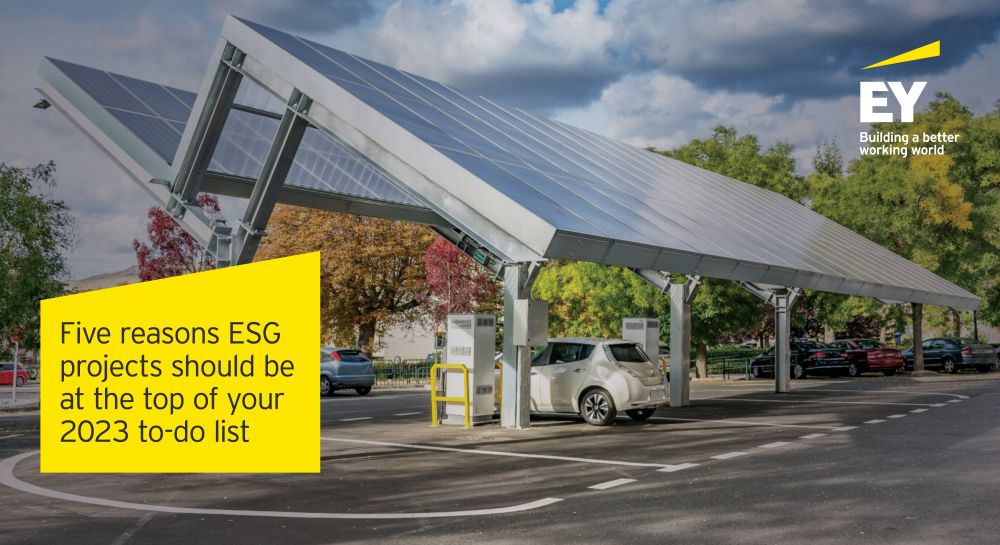Five reasons ESG projects should be at the top of your 2023 to-do list
In his latest blog, EY Global Advanced Manufacturing & Mobility Leader, Randall J. Miller, explains five reasons why ESG initiatives have now become an essential part of running a business, and far more than just an reporting exercise.

In its first 125 years, the automotive industry saw plenty of innovations — some important, others, not so important. Radio and power steering were keepers. Rumble seats and tail fins? Maybe, but to each his own.
Today, most industry observers agree that important transformational changes are underway with sustainability at the forefront. This transition is not a gradual one. As a matter of fact, given the rapidity of the transformation, many industry observers believe that there is only one question for automotive companies and their suppliers. That question is whether they want to be a leader or get left behind.
ESG leading the way
As the transition to electric power gains momentum, combined with growing technology capabilities around autonomous and connected vehicles, an even bigger transformation is taking shape around sustainability. For automotive companies, electrification of their fleet is a critically important step for their future. But market expectations around sustainability have turned the electric vehicle transition into table stakes. Environmental, social, and governance (ESG) initiatives have now become an essential part of running a business, and it is far more than just a reporting exercise. Whatever tomorrow’s automotive industry ecosystem will look like, strong ESG results will, most likely, be a part of the leading players’ profiles. There are five reasons for this:
- ESG performance is becoming an important value driver for automotive companies. The EY proprietary ESG impact model demonstrates that companies that perform well on ESG parameters are more likely to have a higher total shareholder return. Our research found that a 1% bump in ESG performance can do more for the total shareholder value than a 1% gain in earnings before interest and taxes (EBIT) margin. ESG indicators zero in on operations, allowing you to see not only how efficient you are, but also how you can improve.
- Equity investors believe in ESG. Just three years ago, ESG leaders (as defined by the EY organization) traded at a discount to laggards (a 6.6 times enterprise value to earnings before interest, taxes, depreciation and amortization (EBITDA) multiple against the laggards’ 7.8 times). Now, they have almost two times the advantage (8.1 times to 6.2 times). Companies that are incorporating sustainability into their strategies command a substantial premium in today’s market.
- Debt investors value ESG performance too. Companies with strong sustainability value propositions enjoy a lower cost of capital and lower beta. In fact, companies that earned a top-quartile Sustainalytics ESG rating between FY2018 and FY2020 could borrow at 2.9% compared with 3.9% for companies scoring in the bottom two ESG quartiles.
- Strong ESG results can make you a more attractive M&A candidate. One recent study of advanced manufacturing and mobility companies found that 75% of respondents expect to see a rise in M&A activities, driven by sustainability performance. Already, many companies are positioning themselves for a greener future by spinning off carbon-heavy divisions or even shuttering some investments entirely if they foresee a future, where their aging plants can no longer compete.
- Governments favor ESG all-stars. Paying attention to ESG can make you more eligible to take advantage of public funding schemes that support ESG-positive initiatives. These include the US$3b earmarked by the US Postal Service to purchase a new generation of zero-emission delivery vehicles, tax credits for the use of clean fuels and reduced emissions, or access to the €9.7b European Regional Development Fund.
A company can become a high-performing ESG leader only after it begins to understand the full range of ESG risks and opportunities ahead. Such insights cannot be gained before you integrate sustainability metrics deeply into your long-term strategic financial plan. In the automotive industry, in particular, success will depend on the degree to which your company decides ESG is no longer a side project — and not only with respect to sustainability: Embedding sustainability considerations into your strategy will improve your ESG performance and grow your total shareholder return.
Randall J. Miller is the EY Global Advanced Manufacturing & Mobility Leader.
Find out more on the latest EY global insights.






